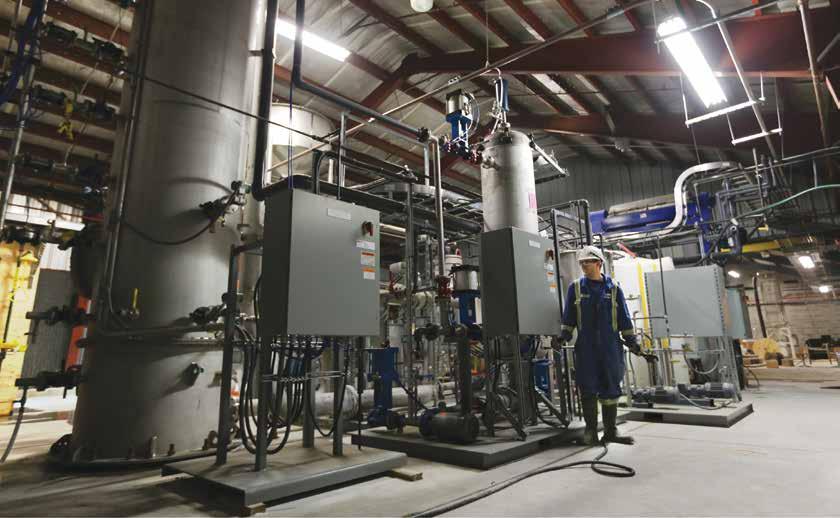
3 minute read
Carbon Engineering: Pioneering direct air capture of CO 2
Rendering of CE’s air contactor design. This unit would be one of several that would collectively capture 1M tons of CO 2 per year.
Carbon Enginee ring: Pioneering Direct Air Capture of CO 2
The transportation sector of 2050 will run on an energy mix unlike that of today. Operators are demanding increasing quantities of low-carbon energy sources and renewable fuels, and the sector is searching for next-generation technologies that will enable compliance with emissions reduction targets. Carbon Engineering Ltd. (CE) is a Canadian-based clean energy company that has developed a technology that can help address these growing needs. CE’s Direct Air Capture (DAC) technology enables CO₂ to be pulled out of the atmosphere at large scale and then permanently stored underground or used to manufacture fuels and other products. This technology provides a marketbased solution that can meet the demands of existing industries, while simultaneously decarbonizing the economy.
CE was founded in 2009 by Professor David Keith, who raised seed capital from a small group of investors, including Bill Gates. Since inception, CE’s mission has been to develop and engineer a system that could be brought to market affordably and at industrial scale, so it could play a mainstream role in cutting emissions and producing clean energy. In 2015, CE built a proof of concept pilot plant in Squamish, British Columbia, that can capture one ton of CO₂ per day. Today, CE is progressing the engineering for commercial-scale DAC facilities that can be built to capture 1 million tons of CO₂ per year at levelized costs
CE’s pilot plant pellet reactor and associated equipment.

of approximately US$100 per ton of CO₂. At that scale, one facility is capturing a quantity of CO₂ equivalent to the emissions from 250,000 cars.
DAC offers a range of opportunities to create environmental benefits and to manufacture products. To date, CE has developed technology for two main uses: permanently storing the captured atmospheric CO₂ underground and utilizing the CO₂ to produce synthetic transportation fuels.
In the former case, DAC is used to permanently store atmospheric CO₂ in geologic reservoirs, creating what is known as negative emissions, or permanent carbon dioxide removal. As companies and nations tackle commitments to reduce emissions, the ability to remove CO₂ directly from the atmosphere is a powerful new tool to include in sustainability toolkits. Additionally, DAC plants can be built adjacent to existing pipelines and oilfields to deliver CO₂ at point of demand for enhanced oil recovery (EOR). When atmospheric CO₂ is used and stored permanently underground during the process, it can partially or completely counteract the emissions from the oil produced.
Atmospheric CO₂ can also be used in the production of clean transportation fuels using CE’s AIR TO FUELSTM technology. This process combines renewable hydrogen with atmospheric CO₂ to produce ultra-low carbon intensity synthetic crude. This “syncrude” can then be processed into gasoline, diesel, and jet fuel
that is drop-in compatible with existing refineries and engines. Due to an unlimited feedstock — atmospheric CO₂ — CE’s AIR TO FUELS™ technology can provide global-scale quantities of clean fuels to meet growing market demand.
In partnership with Oxy Low Carbon Ventures, LLC, a subsidiary of Occidental Petroleum, CE is currently engineering the world’s largest DAC project — a facility that will capture 1 million tons of CO₂ directly from the atmosphere each year to be stored underground permanently in the Permian Basin, U.S. This project is running parallel to the work CE is conducting in other markets, and the company continues to develop project opportunities in locations where CO₂ can be permanently and safely stored underground, and where markets are demanding increasing quantities of low-carbon fuels.
About Carbon Engineering (CE)
Founded in 2009, CE is a Canadian-based clean energy company leading the commercialization of groundbreaking technology that captures CO₂ directly from the atmosphere so it can be stored permanently underground, or synthesized into clean, affordable transportation fuels. From a pilot plant in Squamish, B.C., CE has been removing CO₂ from the atmosphere since 2015 and converting it into fuels since 2017. Learn more at www.carbonengineering.com. v
CE’s direct air capture pilot plant in Squamish, B.C. Shown are the air contactor (foreground) and calciner (upper left).

Always looking for new opportunities in Manitoba and S.E. Saskatchewan’s oil patch.
Manitoba owned and operated for 50 plus years


Border Energy Ltd.
Unit B, 245 King Street, Box 172 Virden, MB R0M 2C0
Office: 204-748-4180 Fax: 204-748-4182 Cell: 204-851-1169 Email: borderel@mts.net








